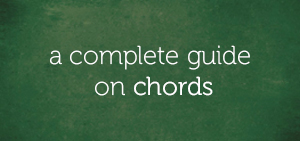In this lesson, I’ll be showing you some of the scale options for dominant chords.
Dominant chords are very vital in popular music harmony for a variety of reasons; the most common being their harmonic function especially in terms of taking up the role of passing chords in a chord progression or song.
For a lot of intermediate keyboard players, this lesson would help you learn a variety of scales that can be played over dominant chords.
But before we go into the scale options, let’s refresh our minds on dominant chords.
A Short Note On Dominant Chords
The term dominant is a technical name used by music scholars to describe the fifth degree in a key – whether major or minor. For example, in the key of C major:
…the fifth degree (which is G):
…is the dominant.
The dominant is the second tone in a key in terms of importance and that’s why we’re dealing with dominant chords in this lesson.
“What Is A Chord?”
A chord is a collection of three or more related notes (agreeable or not), that are played (or heard) together.
Although it takes at least three notes to form a chord, before any collection of three notes can be considered as a chord, there MUST be a relationship between them. For example, G, B and D:
…can be considered as a chord because of the scale and intervallic relationship between the notes – G, B and D.
The notes G, B, and D:
…are the first, third and fifth tones of the G mixolydian scale:
…and that’s the scale relationship between them. Also, there is an intervallic relationship between the G, B and D. The interval between G and B:
…is a third interval, and so is the interval between B and D:
Consequently, the intervallic relationship between G, B, and D is in third intervals.
The Term Dominant Chord – Explained
From what we’ve covered so far, a dominant chord is a collection of three or more related notes (chord), founded on the fifth degree in any given key.
For example, in the key of C major:
…any chord that is founded on the fifth degree (which is G):
…is a dominant chord.
The same thing is applicable to any other key whether major or minor.
In the key of A minor:
…any chord that is founded on the fifth degree (which is E):
…is a dominant chord.
Scale Options For Dominant Chords
There are scales that are compatible with dominant chords and they are basically used while improvising over dominant chords.
I’ll be showing you these scales in this segment, starting from the mixolydian scale.
The Mixolydian Scale
The mixolydian scale is one of the scales that can be played over dominant chords. For example, the C mixolydian scale:
…can be played over the C dominant seventh chord:
…C dominant ninth chord:
…or the C dominant thirteenth [suspended fourth] chord:
“Check Out All The Mixolydian Scales On The Keyboard…”
C mixolydian scale:
Db mixolydian scale:
D mixolydian scale:
Eb mixolydian scale:
E mixolydian scale:
F mixolydian scale:
Gb mixolydian scale:
G mixolydian scale:
Ab mixolydian scale:
A mixolydian scale:
Bb mixolydian scale:
B mixolydian scale:
The Octatonic [H-W] Scale
C octatonic [H-W] scale:
C# octatonic [H-W] scale:
D octatonic [H-W] scale:
Eb octatonic [H-W] scale:
E octatonic [H-W] scale:
F octatonic [H-W] scale:
F# octatonic [H-W] scale:
G octatonic [H-W] scale:
G# octatonic [H-W] scale:
A octatonic [H-W] scale:
Bb octatonic [H-W] scale:
B octatonic [H-W] scale:
The Lydian Dominant Scale
C lydian dominant scale:
Db lydian dominant scale:
D lydian dominant scale:
Eb lydian dominant scale:
E lydian dominant scale:
F lydian dominant scale:
Gb lydian dominant scale:
G lydian dominant scale:
Ab lydian dominant scale:
A lydian dominant scale:
Bb lydian dominant scale:
B lydian dominant scale:
The Spanish Phrygian Scale
C spanish phrygian scale:
C# spanish phrygian scale:
D spanish phrygian scale:
D# spanish phrygian scale:
E spanish phrygian scale:
F spanish phrygian scale:
F# spanish phrygian scale:
G spanish phrygian scale:
G# spanish phrygian scale:
A spanish phrygian scale:
A# spanish phrygian scale:
B spanish phrygian scale:
The Hindu Scale
C hindu scale:
Db hindu scale:
D hindu scale:
Eb hindu scale:
E hindu scale:
F hindu scale:
Gb hindu scale:
G hindu scale:
Ab hindu scale:
A hindu scale:
Bb hindu scale:
B hindu scale:
The Super Locrian
C super locrian scale:
C# super locrian scale:
D super locrian scale:
D# super locrian scale:
E super locrian scale:
F super locrian scale:
F# super locrian scale:
G super locrian scale:
G# super locrian scale:
A super locrian scale:
A# super locrian scale:
B super locrian scale:
Final Words
Chuku Onyemachi
Latest posts by Chuku Onyemachi (see all)
- The Formation Of Diminished Seventh Chords Used To Be Challenging Until I Did This
- How To Form Seventh Chords In Two Shakes Of A Dog’s Tail Using Third Intervals And The Circle Of Fifths Chart
- I Played The 13sus4 Chord And This Happened…
- How To Build Seventh Chords Like An Architect Using “Foundation And Structure” Concept
- This 4-Week Plan Will Help You Master All The Major Scales







Comments on this entry are closed.